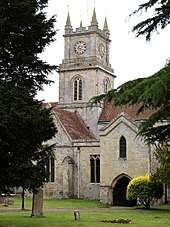Alice Kipling
Alice Caroline Kipling (4 April 1837 – 22 November 1910) was one of the MacDonald sisters, four Scottish women of the Victorian era, notable for their contribution to the arts and their marriages to well-known men. A writer and poet, she was the mother of the author Rudyard Kipling.

Early years
Alice Kipling was born as Alice Caroline MacDonald in Sheffield, England in 1837, the first of the four daughters of Reverend George Browne MacDonald (1805–1868), a Wesleyan Methodist minister,[1] and Hannah Jones (1809–1875).[2][3][4][5][6]
In her youth Alice MacDonald wrote sonnets. She was described as:
"...slender, pale complexion, dark brown hair and grey eyes, with black lashes and delicately pencilled eyebrows. In those eyes lay the chief fascination of her face. So expressive were they that they seemed to deepen or pale in colour according to passing emotion .. it was impossible to predict how she would act at any given point. There was a certain fascination in this, and fascinating she certainly was..."[7]
Marriage and India

John Lockwood Kipling and Alice MacDonald met in 1863 and courted at Rudyard Lake in Rudyard, Staffordshire, England. They married in St Mary Abbots Church, Kensington on 18 March 1865 and moved to India later the same year. They had been so moved by the beauty of the Rudyard Lake area that when their first child was born they named him after it. Two of Alice's sisters married artists: Georgiana was married to the painter Edward Burne-Jones, and her sister Agnes to Edward Poynter. Kipling's most famous relative was his first cousin, Stanley Baldwin, who was Conservative Prime Minister three times in the 1920s and '30s.[8] He was the son of Alice's sister Louisa and her husband Alfred Baldwin.
Harry Ricketts in his biography of Rudyard Kipling wrote of Alice that she:
"...was lively, witty and talented; in a Jane Austen novel she would have been called accomplished. She wrote and published poems, arranged songs, sang and sewed and knew how to run a household. Her racy, gossipy letters captured acquaintances and social situations in phrases that flickered between mischief and malice. Frederic, her younger brother, thought her 'keen, quick and versatile' beyond anyone he had ever known. She 'saw things at a glance', he recalled, 'and dispatched them in a word'. Her poems showed another side, revealing a deep strain of melancholy..."[9]
In January 1865, John Lockwood Kipling was made Architectural Sculptor and Professor of Modelling at the School of Art and Industry in Bombay. Alice became the mother of Rudyard Kipling on 31 December 1865.[10] In Simla, Lord Dufferin once said, "Dullness and Mrs Kipling cannot exist in the same room."[11][12][13]
Later life

Alice Kipling and John Lockwood Kipling remained in India for many years, including during the period when their children were being educated in England. Alice Kipling published much less of her writing than did her sisters, but some of her poems were published in collections including Quartette (1885) and in Hand in Hand: Verses by a Mother and a Daughter (1901), the latter a collaboration with her daughter Alice Fleming (1868–1948).[14]
She died in November 1910, three days after suffering a heart attack[15] and is buried beside her husband in the churchyard of St John the Baptist in Tisbury in Wiltshire, England.[16][17]
Alice Kipling features in the 2002 biography A Circle of Sisters: Alice Kipling, Georgiana Burne-Jones, Agnes Poynter and Louisa Baldwin by Judith Flanders.[18]
References
- Ina Taylor. Victorian Sisters. Weidenfeld and Nicolson, London p6 1987 ISBN 029779065X
- Taylor, Ina Victorian Sisters 1987 Weidenfeld & Nicolson p13 ISBN 029779065X
- Judith Flanders, A Circle of Sisters (London, U.K.: Penguin Books, 2001), page xv-xvi
- UK Census Returns. Public Records Office. Scanned Documents - Online (1841-1911) [www.ancestry.co.uk] (n.p.: n.pub., unknown publish date), (1891)
- "Wharfedale & Craven Genealogicial Study"; Ancestral File unknown repository, unknown repository address
- Norman Page, A Kipling Companion, MacMillan Press, London (1984) - Google Books pg 28
- Lycett, Andrew, Rudyard Kipling, Phoenix London (2000) pg 13
- thepotteries.org (13 January 2002). "did you know ..." The potteries.org. Retrieved 2 October 2006.
- Harry Ricketts, Rudyard Kipling: A Life, Carroll & Graf Publishers, Inc. (1999)
- Jill Berkiminez, (15 October 2013), Dictionary of Artists' Models, Routledge. pp. 91–. ISBN 978-1-135-95914-2
- "The Life of Rudyard Kipling", Charles Carrington, 1955, p. 51.
- http://www.kiplingsociety.co.uk/rg_rival1.htm
- The Long Recessional: The Imperial Life of Rudyard Kipling - David Gilmour - Βιβλία Google. Books.google.gr. Retrieved 2015-11-26.
- Alice MacDonald Kipling: the Kiplings and India: A Collection of Writings from British India, 1870-1900
- Rudyard Kipling: In Sickness and in Health - The Kipling Society database
- Grave of Alice MacDonald Kipling on Find a Grave website
- Photograph of the Inscription on grave of Alice Macdonald, Mrs John Lockwood Kipling (1837-1910), Tisbury, Wiltshire: 1950 - National Trust Collection
- Judith Flanders, A Circle of Sisters: Alice Kipling, Georgiana Burne-Jones, Agnes Poynter and Louisa Baldwin, Penguin (2002) ISBN 978-0140284898
External links
- Portraits of Alice Kipling on the